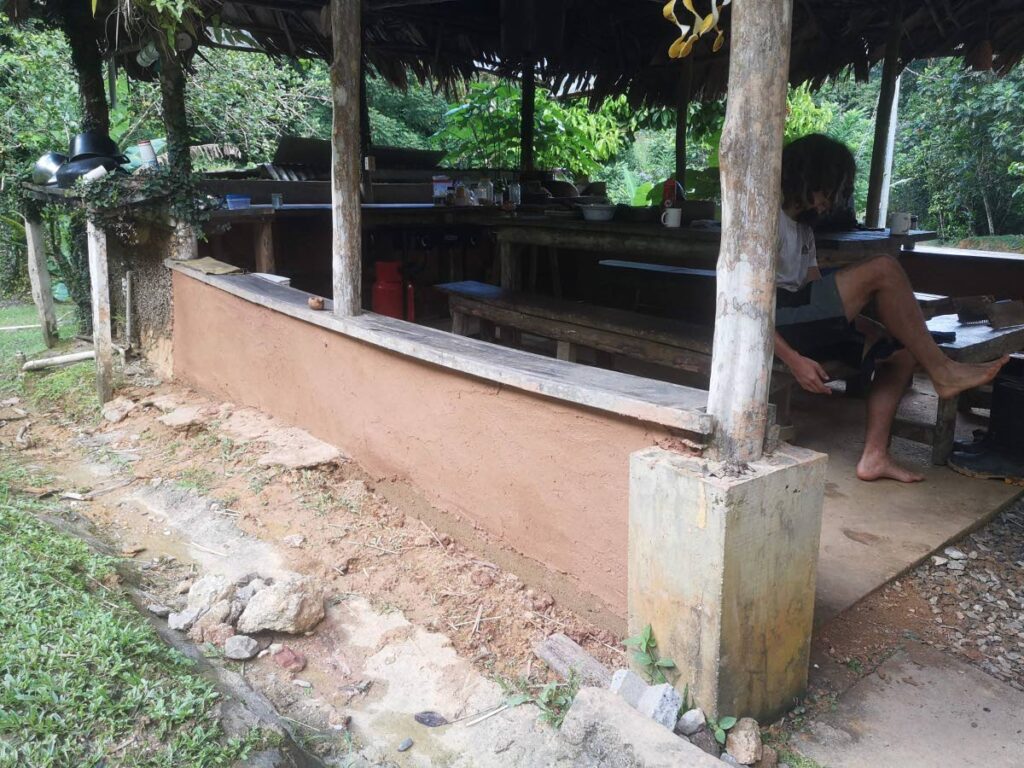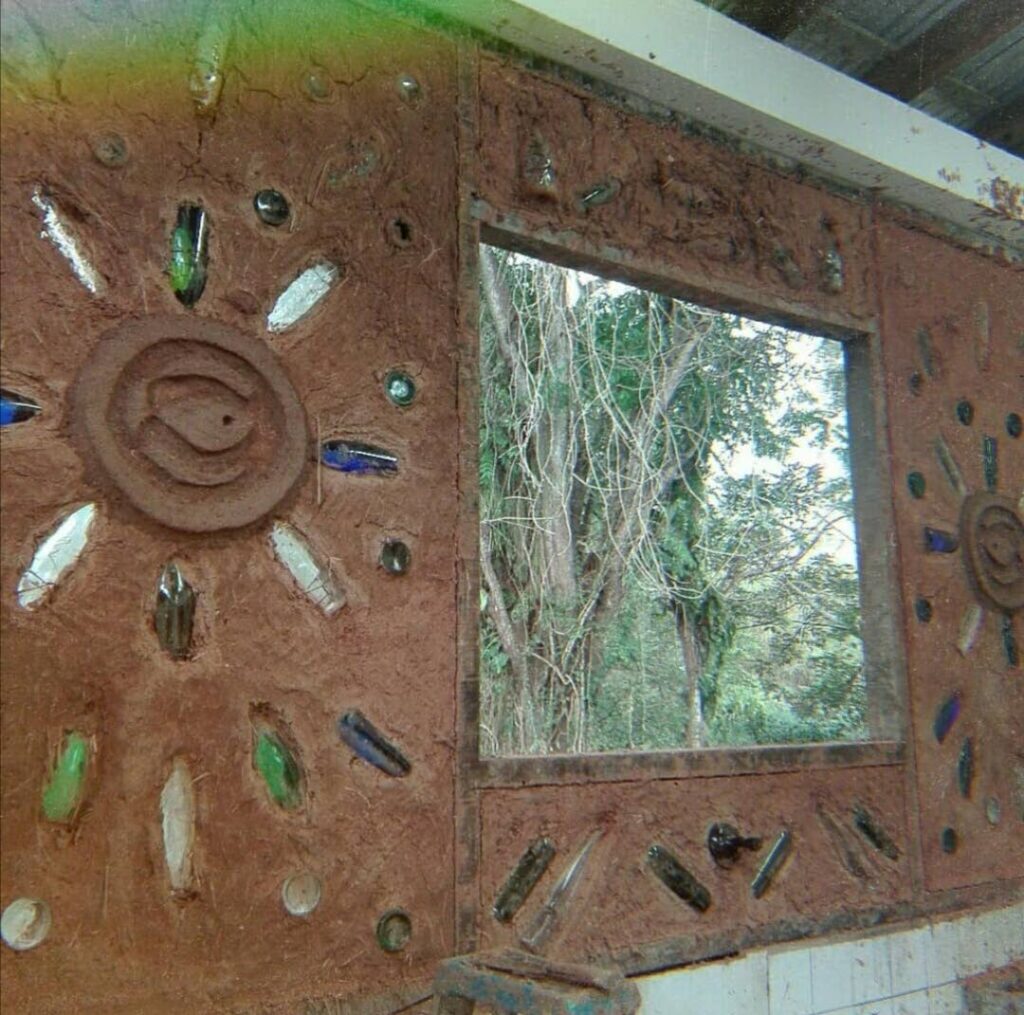Building with earth

Celine Ramjit is an uncommon artist, seeking relevance and spirituality, and finding avenues of expression in tattoos and tapia. She tells her story to Pat Ganase.
At 30, Celine Ramjit considers herself an artist working in eco-architecture and natural weaving; and continuing to experiment with body art through tattooing. She is in an integrative phase, converting her education and recent experience into a unique vision: building a community and a homestead that are ecologically friendly, through an art practice that is immersed in nature.
Ramjit grew up in south Trinidad where she was influenced by nature and art. She is the eldest of four, (one brother and two sisters) to her mother, Nimi and her father Ralphy who died when she was ten. She attended Rio Claro Presbyterian, then Tableland High School, finishing her CAPE ‘A' levels at Rio Claro (College) West Secondary, where in 2012, she placed first across the Caribbean in Visual Arts.
She started a tattoo apprenticeship in 2013 which revealed the anthropological history of body art in various cultures and provided a perspective for tattoos in contemporary society. In her final exhibition at UWI, she designed and created a body of work inked on leather. This collection was a series of mandalas based on life and death, vulnerability and power, certainty and uncertainty. The inked works in sets of three reflected tantric mandalas found in east and south east Asian culture, religion and philosophy. Ramjit continues to ink today, sharing this form of art with tattoo clients and friends. She has inked most of the work on her body herself.

Ramjit became a mixologist on Ariapita Avenue for six years, and learned liquor chemistry; she added a day job as a secretary in a law firm in the last couple years. By 2019, she felt the need to retreat and reflect. It was a pivotal point in her life: questioning her direction and career choices. She spent Carnival week at Wa Samaki (the permaculture farm operated by Erle Rahaman-Noronha) after which she volunteered to work on the farm and especially for an earthworks project being facilitated by Fyto Sandoval, a natural builder from South America; he opened her awareness to art and design in natural building. Since then, she has worked on projects focusing on alternative, regenerative, ecological forms of natural building that use sustainable technology and design.
At Wa Samaki she was a core team member and taught natural building and weaving (native grasses) courses in workshops and the internship programme. Participants got hands-on training in design and application of concepts through practical builds using local clay and grasses; they were encouraged to appreciate the connection of buildings and the home as extensions of Mother Earth. She remained at Wa Samaki until August 2021.
What is natural building?
Natural building is the practice of construction using unfired, untreated, raw earth – locally sourced – in combination with recycled or salvaged materials. Such buildings minimise their ecological impact by incorporating design practices that arise out of and integrate with the environment. Raw earth, or clay, is abundant everywhere on earth and has been used – combined most commonly with sand and grass – since our early explorations in constructing dwellings. The walls are sealed in earthen finishes and plasters that are impervious to weather and can last for decades.

There are many advantages to working with clay as a building material; it is cost effective and abundant, highly durable, able to store and release heat, and insulate spaces. It is non-toxic, non-allergenic, with low environmental impact both during and after construction. It is estimated that 1.5 billion people (30 per cent of the world population) live in earthen dwellings. The cement industry releases eight per cent of global carbon dioxide (CO2) emissions. In contrast, the embodied energy used to create and demolish earthen structures have a low carbon footprint and clay is entirely biodegradable.
Ramjit was recently commissioned to repair the wall of an outside kitchen in Brasso Seco. With her guidance, it was rebuilt by her team of eco builders and clay enthusiasts. “You could always re-use material from the original structure by incorporating with fresh clay, grass, wood shavings, whatever is at hand. You have to understand how the materials are combined and work together.”
Other considerations in natural building involve optimum design that considers the environment (natural drainage and water table), the climate (wind and rainfall), and the embodied energy in the maintenance of building through its life. In TT, the seasons – dry or wet – are important when planning these builds. The dry season is a good time for ground work to be done, and optimal for allowing earthen walls to dry.
She rejects the misconception that earthen architecture should be used for small structures, or primarily housing in poor or rural areas. There are examples of multi-storey buildings, airports, embassies, hospitals, museums, schools and factories made from clay. Archaeologists have found evidence of mud brick buildings constructed ten thousand years ago in the Middle East and North Africa, with many specimens and forms in Britain, France, the US, Peru, Yemen, Iran, India, Morocco and Mali. Here in Trinidad these houses are called tapia: they use wooden frames supporting walls from raw earth combined with grasses or bark or wood shavings or manure, using voluntary labour called gayap. Leepay refers to a plastering mixture of cow dung, clay and water used mainly to create smooth floors.
Ramjit said, "Anyone can do it. Sell the idea that you can build it yourself to yourself." Of course, there is both science and art to earth building that may be studied through the buildings that already exist. The starting point is with materials common to all natural building – clay and sand. Other materials include timber for the frame, posts and beams; bamboo; straw, vetiver grass; stone or gravel; sawdust, and recycled material such as glass bottles or tyres. Additives such as molasses and linseed oil treatments go directly into the cob or clay to waterproof and seal these structures.
Philosopher of clay
Ramjit believes that building is an art. It is a very public form of art; and can be expressive and explorative. The energies, from the humans that build, may be considered spiritual. Building with clay is working with a living, interactive material. Through practical earthworks, she has the opportunity to teach the versatility and dynamism of local clays; and to share techniques for the design of organic forms suited to function. Consider her bottle walls which emerge as relief sculptures with personality and a narrative. She plays with themes that question disconnection and reflect reconnection to the earth, science and cosmology, the intelligence of nature, folklore and mythology, space and time. Her work examines the seen and unseen, that which is microscopic and macroscopic, through molecular biology and chemistry.

Her earthen wall installations are inspired by Jeremy Narby's work in Shamanism, and the belief in the mystical, living qualities of clay. She believes that earthen works are transformative from the initial design and concept stages, immortal in many ways, healing to the environment as well as to the builder and resident. Her experience of working with clay is grounding, nurturing, expanding imagination, tapping into the creative force.
Who does Ramjit work with?
“My friends are fire,” Ramjit said. “They are a collective of ten to 15 individuals that I can call on, though most projects sometimes may not require all energies at once. It always depends on the project at hand. My team has worked with me on many projects and workshops, we learn together and exchange our experiences, and seek work with like-minded individuals within the community. In natural building, you learn best by doing, you have to feel the material as it changes and develops in each step or stage. I'm constantly learning with each project and each clay body that I use. These are collaborations of energy and minds and hands and feet. The collective is strong like the earth and the earthen walls we build, we are that tribe.”
Ramjit is excited about the future and looking for new opportunities to build. There is the prospect of collaborating on a project at Ajoupa Gardens: “I’m delighted and excited at the possibility to be working with ceramics creatives, Rory and Bunty O’Connor. The strength of ceramics comes from its purifying process, while natural building depends on all the little micro-organisms, all the living biochemistry occurring in the clay which make strong bonds that do not need to be fired. I think there much to be shared and learn together.”

Comments
"Building with earth"